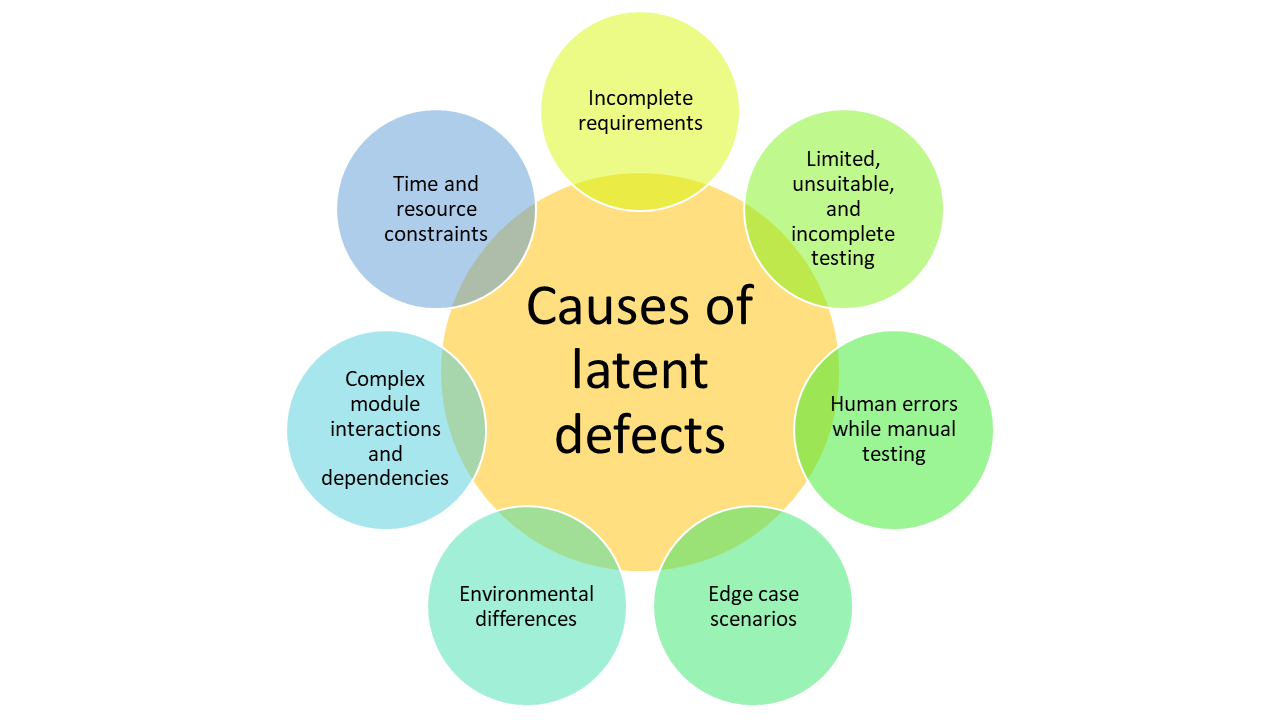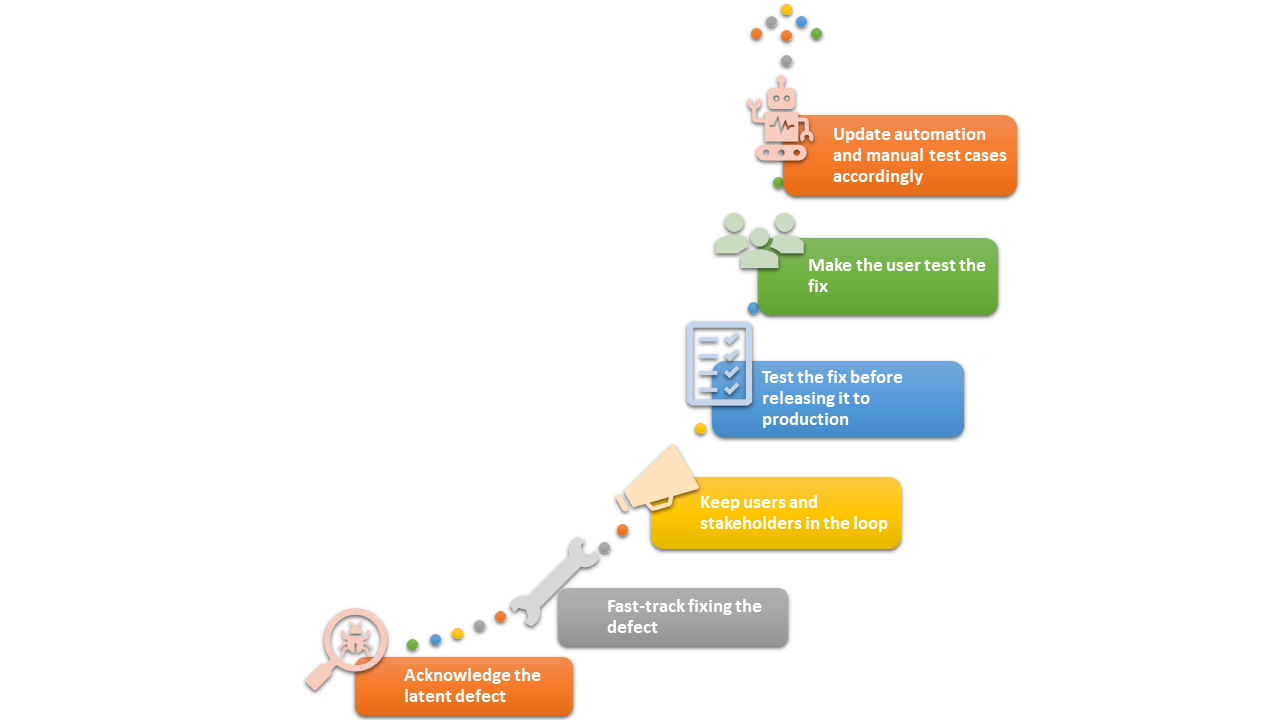Latent Defects Decoded: The Hidden Perils in QA
|
|
You must have heard about the Y2K defect, the ‘Millennium Bug,’ where there was a problem in computer systems and software that was anticipated to cause widespread malfunctions when the date rolled over from December 31, 1999, to January 1, 2000. It was rooted in how dates were programmed into software. The defect stemmed from a cost-saving convention used in early computer systems. Due to memory and storage limitations, especially in the earlier days of computing, programmers often used two digits to represent the year instead of four.
Latent defects
This is a classic example of a latent defect that existed in the system but was dormant until certain conditions were met.
What are latent defects?
In the world of QA, latent defects are a nightmare. They are those errors in the system that remain undiscovered, even after the product is released. These defects become apparent only after the product has been in use for some time, thus threatening the product’s credibility, eroding user trust, and leading to substantial rework and costs.
What conditions lead to latent defects?
Latent defects usually crop up in the system due to the below-mentioned reasons.

How do we identify latent defects?
These issues go undetected and survive rounds of testing and, hence, are difficult to pinpoint. However, here are some symptoms that, if noticed in your system after being used for a while, are likely caused by latent defects.
- Unexpected system behavior
- User reports bugs or gives feedback on anomalies
- System failures
- Inconsistency in data
- Performance issues
Quite often, it is difficult to reproduce these issues as well.
How are they different from masked defects?
Both latent and masked defects go unidentified but due to different reasons.
Latent defects
When it comes to latent defects, they remain dormant and may only become evident when specific conditions or triggers are met.
Example: Consider a software application that crashes only when used in a specific region due to a time zone calculation error. If testers in the other areas tested the application, they wouldn’t encounter the defect, making it latent.
Masked defects
On the other hand, a masked defect is a flaw or error that is present and active in a system or product but is concealed or ‘masked’ by the presence of another defect or system behavior. Thus, you can say that masked defects are active but concealed by another defect or behavior.
Example: Consider a banking software application that has a defect where the transaction history is not showing amounts greater than $5000. However, there is a second defect that prevents the users from downloading/viewing the transaction history. This second defect masks the $5000 defect. Only after the download/view of the transaction history defect is fixed would testers discover the $5000 defect.
Ways to catch latent defects
Though latent defects cannot be eliminated entirely, they can be reduced to a bare minimum by being thorough with QA. Here are some techniques you should pay heed to.
- Comprehensive requirements gathering: Though requirement gathering is usually present at the start of any test cycle in SDLC, it is an evolving process that should go on throughout the cycle. What I mean by this is that as you get into the nitty-gritty of developing the product with various stakeholders, you will encounter many possible use cases that would not have been documented in the requirement-gathering process. During those times, be diligent in documenting these exceptional cases and testing them as well.
- Continuous integration and testing: Use the CI process to add a safety net. Integrate automated testing into the pipeline so that repetitive test scenarios are accurately covered. Read about TestOps and DevTestOps to gain more information.
- Diverse testing scenarios: Usually, the test environment is very different from the real world or production environment. These differences tend to seep through as latent defects. Try to use techniques like testing in production, exploratory testing, and other creative ways to unearth edge-case scenarios.
- Feedback loops: Use testing techniques like alpha and beta testing to get early feedback from actual users.
- Automated testing: While they can’t replace human testers, automated tests are consistent and tireless, ensuring that the same test is run the same way every time. Moreover, if you intend to work with large data sets, then automation testing can handle data-driven testing. This will help you widen your testing scope and cover more ground. Automated testing also gives a layer of protection and frees staffing to work on other cognitive forms of testing.
- Monitoring: Use monitoring tools to observe how users interact with the product and catch anomalies. Learn more about test monitoring and control.
- Regression testing: This should be a staple of your QA process. Use automation to ensure that this form of testing can be delegated and run swiftly and accurately. You can find various powerful and user-friendly tools in the market, like testRigor, for this purpose.
- Performance testing: Different performance testing techniques, like load testing and stress testing, should be done to ensure the system is healthy and functioning as expected.
Through all these approaches, you can achieve exhaustive testing and widen your test coverage, which will ultimately help flush out defects early on from the system.
How do we handle these defects once they have been identified?
Users usually bring up these defects. Thus, you need to be prompt with your actions. You can follow the below flow to manage such situations.

Test automation to combat latent defects
In the above sections, we saw that test automation can be a great way to fortify the system against defects leaking into production and turning into latent defects. Moreover, if you pick a powerful, AI-based automation testing tool like testRigor, then your chances of success are only going to get multiplied.
Using testRigor against latent defects
testRigor uses AI under the hood to give you the best features when it comes to test case creation, execution, and maintenance.
With the help of AI, testRigor closely mimics English and allows its users to write test cases in it. You can write simple and complex test cases, be it functional, cross-platform, cross-browser, or UI-based, in plain English statements. It doesn’t stop there. You can bid farewell to the woes of writing XPaths and CSS tags for UI elements and simply write how they appear to you on the screen. testRigor will do the thinking and identify the element on the screen. There is even a record-and-playback feature for test case creation. Thus, all team members, irrespective of their technical proficiency, can participate in the QA process, promoting collaboration.
With this simplicity, you can create different kinds of test suites for regression testing, smoke testing, and even production testing. This tool offers a variety of rich features that will not only make automating test scenarios easier but also give you the comfort of writing test cases that closely resemble the English language used to write manual test cases.
Test maintenance is not a burden if you use testRigor since it uses self-healing capabilities. The tool’s infrastructure takes care of giving you test runs that are not flakey and are reliable enough for monitoring purposes. Combine that with the added advantage of being able to integrate with multiple platforms like test management tools, CI tools, device farms, etc., and you can build an entire QA arsenal that will reduce the likelihood of latent defects occurring to a bare minimum.
Conclusion
Latent defects, while challenging, are not indomitable. Organizations can substantially reduce their occurrence with rigorous processes, user feedback, and a commitment to continuous improvement. Remember, the ultimate goal is to ensure the end-user has a seamless experience. While it’s impossible to guarantee a product free from defects, a proactive stance using modern test automation tools like testRigor can minimize their impact.
| Achieve More Than 90% Test Automation | |
| Step by Step Walkthroughs and Help | |
| 14 Day Free Trial, Cancel Anytime |












